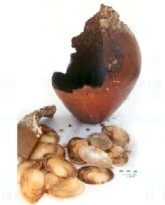EB Jar containing Nilotic Shells

EB Jar Containing Nillotic Mollusks
A whole jar was recovered from the sea floor north of the Crusader fortress off Atlit, at a water depth of 11.5 m and at a distance of ca. 750 m from the shore. Lying by the jar and inside the vessel were shells of non-local fresh water mollusks. The jar and mollusks were recovered in the course of an underwater rescue survey carried out by the Israel Antiquities Authority. The jar has an ovoid body with a narrow flat base, a short neck, a rounded averted rim and a narrow mouth. Three non-pierced vestigial knobs are positioned around the shoulder. The petrographic analysis revealed that the amphora was made with ‘potters clay’ (a non-calcareous alluvial clay) that originated from the Nile. The shells were identified by Henk M. Mienis (per comm.) as Aspatharia rubens originating from the Nile river, and were dated by 14C to the 4th millennium BC by Israel Carmi and Elisabetta Boaretto of the Weizmann Institute. Based on the comparable ceramic vessels in Egypt from the Lower Egyptian site of Maadi, the petrographic findings and the mollusks, it seems that the jar can be dated to the Early Bronze Age IA (3400-3000 BC). The jar must have arrived to the Atlit region on a sea vessel.

EB Jar Containing Nillotic Mollusks
The involvement of the southern coastal plain of Israel in the contemporary long-shore traffic is only beginning to attract attention, however no definite archaeological finds have been found so far. The jar discovered off the Atlit coast is so far the only archaeological find that has been recovered, which points to a maritime connection between Egypt and the northern coast of Canaan. Thus, it seems that the northern bay of Atlit served as an anchorage site for sea vessels as early as the EBIA period.